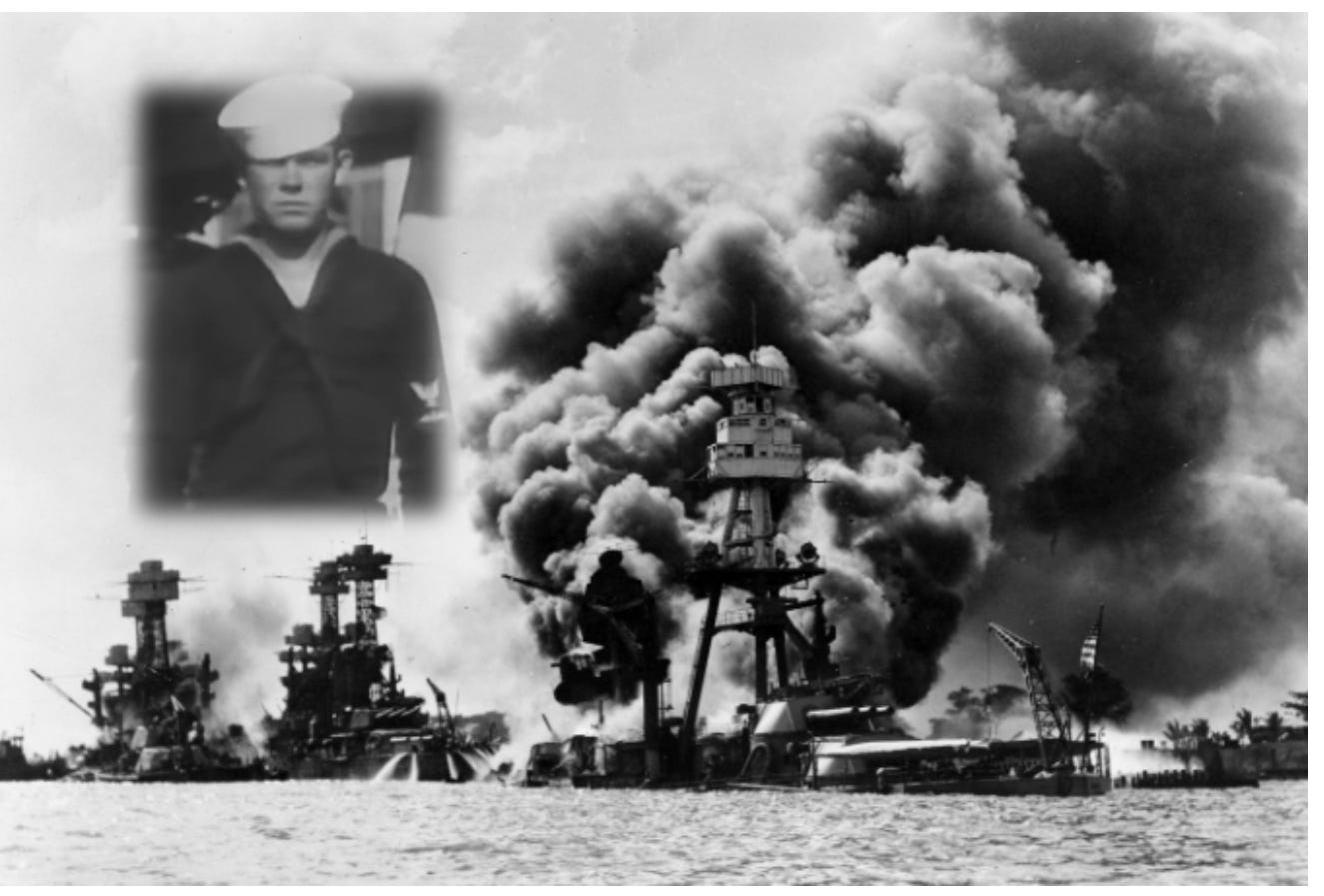“For extraordinary heroism… [On] December 7, 1941, [John Finn] promptly secured and manned a machine gun mounted on an instruction stand in a completely exposed section … which was under heavy [Japanese] machine strafing fire. Although painfully wounded many times, he continued to man this gun and to return the enemy fire vigorously and with telling effect throughout the enemy strafing and bombing attack and with complete disregard for his own personal safety.” —John Finn’s Medal of Honor citation
There are so many inspiring, beautiful stories about the great heroes of American history which are scarcely ever told. One happens on them accidentally—buried in a thick, out-of-print biography, in small print on a museum sign, casually and fleetingly mentioned in an obscure educational video. America cannot return to greatness in the future if we do not truly understand the greatness of our past. That is why I am writing an article series to tell a few of these little-known but moving or illustrative “untold stories” of American greatness. Other articles in this series include Harpo Marx, comedian, musician, and fighter for Jewish rights; how the white citizens of Greencastle stopped Confederates from enslaving black Pennsylvanians; heroic Medal of Honor recipients; John Callendar, the coward who became a Patriot hero; and Tim McCoy, actor, army officer, cowboy, and Indian expert and ally.
Today’s story is about John Finn, an enlisted Navy service member whose dogged perseverance and exceptional courage under enemy fire during the Pearl Harbor attacks earned him the first Medal of Honor awarded for World War II.
Finn, the grandson of an Irish immigrant, remembered how his grandpa wanted one thing: to “be an American.” That patriotism was strong too in John Finn, who was eager to make the U.S. Navy his life’s career. Little did he know that he would be injured in the Japanese attack on Hawaii military targets that killed over 2,000 Americans and launched America into World War II.
John Finn was not expecting to be under enemy fire that Sunday morning in 1941, but he jumped into action and fired at the Japanese planes from an exposed position, continuing to fire even after receiving more than 20 wounds. He survived, thrived, and earned not only the Medal of Honor but multiple other awards as well.
The rest of this article is taken from my piece published in full on PJ Media.
U.S. military officers might have had good reason to worry that the Japanese would strike Pearl Harbor and its battleships, but unfortunately most military personnel and civilians had not been prepped by disturbingly unprepared commanders. John Finn was one of those who woke up on Dec. 7, 1941, little expecting he would witness death rain from the heavens and history in the making that day.
Finn, a chief petty officer at Naval Air Station Kaneohe Bay, was in charge of the sailors who did maintenance on PBY Catalina flying boats’ weaponry. Finn and his comrades were some distance from Pearl Harbor, but they still were targets of the deadly Japanese attack.
Finn was at home that Sunday morning when he unaccountably heard gunfire. A neighbor told him he was immediately needed at his station. He didn’t have far to drive, but it was a long enough trip that he was able to see the Japanese warplanes flying down like birds of prey, firing machine guns at the air station.
Though the PBY Catalinas couldn’t get off the ground, Finn’s men were manning the mounted machine guns to fire on the attacking planes. Wanting to jump in and help, Finn took a machine gun from a member of his squad and attached it to a movable tripod. Rather than find a place to hide and fire from, the chief aviation ordnanceman set himself up in the open, ensuring he had a clear view of the incoming attackers.
While continuing to shoot at the Japanese planes, Finn suffered multiple injuries, but they didn’t stop him from holding his ground for two hours. In all, he suffered 21 individual wounds, including a bullet in his foot and a serious shoulder injury. Eventually, he went for medical treatment, but it didn’t stop him for long. Once tended to, Finn returned to lending aid, this time arming the planes that hadn’t been destroyed in the attack.
Finn’s bravery was quickly recognized and rewarded. In 1942, he was commissioned as a Limited Duty Officer, and on Sept. 14, 1942, he was awarded the Medal of Honor by Admiral Chester Nimitz himself on the aircraft carrier USS Enterprise. Finn was the first Medal of Honor recipient of the Second World War, according to the Pearl Harbor website.
Read Also: Untold Stories: Heroes of Pearl Harbor
Nor did Finn’s service stop with the end of the war. He served 15 more years after his courageous actions at Pearl Harbor, and retired as a lieutenant in 1956. “Before his death on May 27, 2010, John Finn remained an active member of the World War II veteran and Medal of Honor recipient communities,” the Pearl Harbor website notes. “He did his best to make as many appearances as possible, even when he reached advanced age and traveling became difficult.”
Finn’sother awardsinclude the Purple Heart award, the “American Defense Service Medal, Base Clasp; American Campaign Medal; Asiatic-Pacific Campaign Medal; World War II Victory Medal; and the Navy Occupation Service Medal, Asia Clasp.” He was also given a Good Conduct Medal with two bronze stars.
On the anniversary of the 1941 day that went down in infamy, we should remember and honor all those like John Finn who fought and shed their blood for liberty.





God Bless our Heros! 🙏🙏🙏
Do not grieve if such men die, thank God that such men lived.